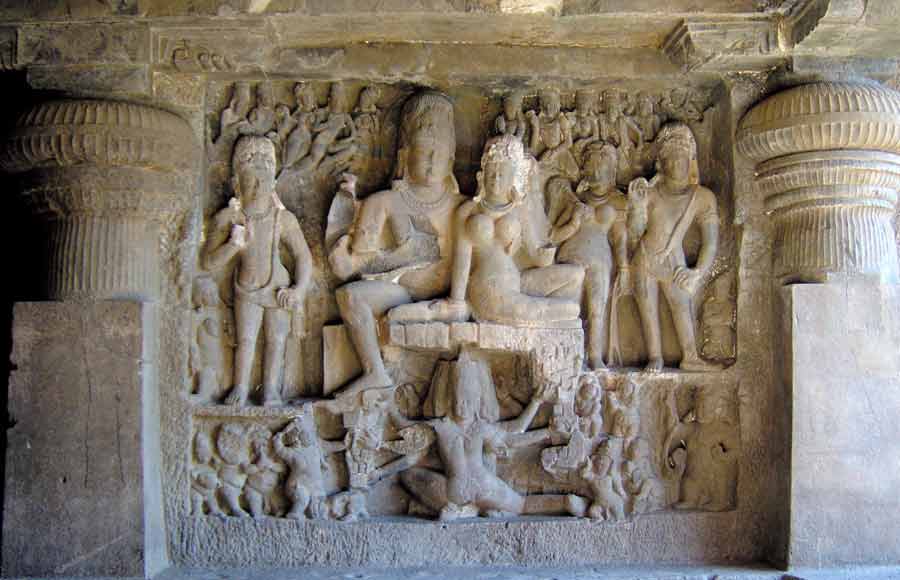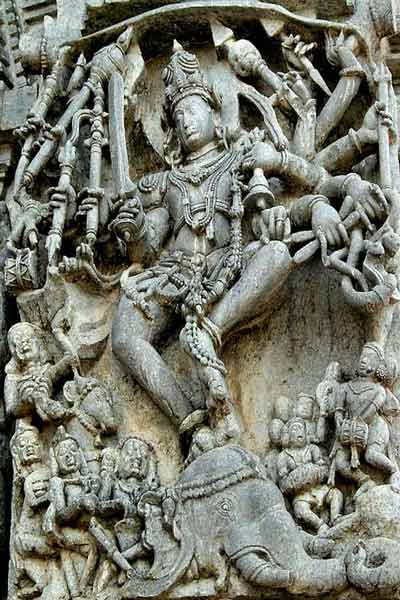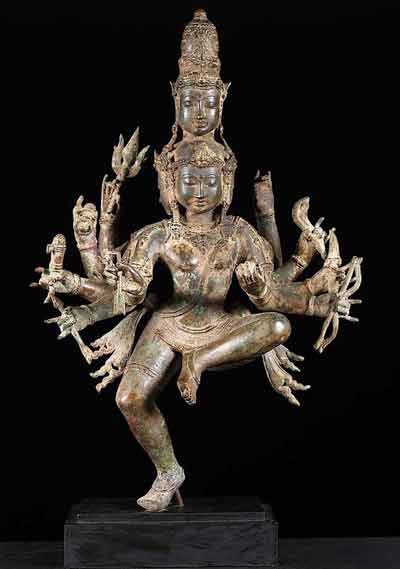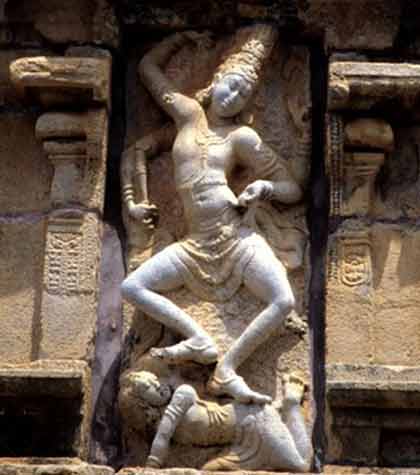
Entrance to the temple precincts of Kailasa, Ellora Caves
Having briefly surveyed evidence that Shaivism (the term encompasses both the śiva-dharma of the lay adherents and the mantra-mārga of
Tantric initiates) was a coherent and distinct religious tradition, one that Brahmanism (vaidika-dharma) resisted the encroachment of, we may now
begin to contextualize its sources (focusing on those of the much better documented Mantramārga, a.k.a. Tantric Shaivism). These may divided into two main
phases: the scriptural and the exegetical. The former consists of anonymously authored texts seen as divine revelations ascribed to Śiva or the Goddess,
and often consisting of a dialogue between the two. Their subject matter is generally categorized in terms of ritual (kriyā), periodic observances
and vows (caryā), meditative and visualization practices (yoga), and doctrine (jñāna), usually in that order in terms of space
devoted to each topic. These texts, of which hundreds have survived, could range from 100 to 24,000 verses, [1] and were composed from approximately 500 to 1200 ce, with the bulk of them in the
7th to 10th centuries.[2] They were authored, in general, by non-brāhmins or brāhmins
far removed from the Sanskritic heartland, for their language is peppered by regular irregularities and clear vernacular influence, as well as sometimes
suffering from an impoverished vocabulary and/or poor command of Sanskrit grammar. This contrasts greatly with the second phase of Śaivite texts, the
exegetical phase. For these texts, composed from the ninth to the fourteenth centuries and also numbering in the hundreds (possibly thousands, originally),
were in the main composed by learned brāhmins in sophisticated language, often utilizing the intellectual tools of pan-Indian rational debate. In this
article, we will be examining the scriptural literature; Part Three (appearing next month) will deal with the exegetical literature commonly labelled today
as “Kashmir Shaivism”.

Hoysala sculpture of Shiva dancing on a demon elephant representing illusion.
Chennakesava Vishnu Temple, Belur, Karnataka, India, 1117AD.
Sources of the Scriptural Materials
When we do a survey of the scriptural materials of Shaivism, we immediately confront a surprising fact: that the vast corpus of Śaiva Tantric scriptures
only rarely paraphrases or even alludes to earlier non-Śaiva sources. This initial surprise is somewhat allayed by the realization that, as texts that
professed to be a new divine revelation, they would attempt to conceal any indebtedness. Still, it seems unusual that amongst the panoply of new ideas of
all sorts we find, in terms of precedents, only a vague conceptual continuity with some of the earlier Upaniṣads, plus the obvious adoption and adaption of
the tattva-system of the Sāṅkhya school. Evidence of specific and sure allusions to earlier non-Śaiva texts is scanty. This is surely because
Shaivism considered itself as a self-contained religious tradition, not a mere permutation of the Vedic dharma. Sanderson, always on the lookout
for historical connections and evidence of dependence, wrote this after reading hundreds of primary sources in manuscript:
“As for hard evidence of [Śaiva scriptural] dependence on datable [non-Śaiva] literary sources, I have as yet little to offer. The Mataṅga-pārameśvara paraphrases the Sāṅkhya-kārikā of Īśvarakṛṣṇa (c. a.d. 350-400), and echoes the definition of sense-perception
formulated in the Pramāna-samuccaya of the Buddhist Dignāga (c. a.d. 480-540), and elaborated in the Nyāya-bindu of Dharmakīrti (c. a.d.
600-660). The Jayadratha-yāmala echoes the Āgama-śāstra of Gauḍapāda (c. a.d. 550-700).“ (2001: 16-17)
In other words, out of hundreds of scriptural texts, Sanderson could only cite two that echoed passages in earlier literature. (Note that such dependence
is as much on Buddhist sources as ones that would later be categorized as Hindu.) Aside from these few instances of textual dependence, if we ask the more
general question of which earlier schools of thought influenced the formation of Śaiva scriptural doctrine, then I would answer only Sāṅkhya, Dharmakīrti’s
and Bhartṛhari’s writings, and possibly some elements of Yogācāra Buddhism. Even the earliest Tantric Śaiva scripture, the Niśvāsa-tattva-saṃhitā
(c. 500 ce), exhibits startling originality in cosmology, soteriology, and praxis.[3]
The debt Shaivism owes to Sāṅkhya—to which probably all forms of Indian philosophy owe a debt (see Larson 1969)—was greatest, for it subsumed much
of the Sāṅkhya ontology within its own larger system (though it also reversed and reinterpreted some of Sāṅkhya’s fundamental notions). The 25-tattva hierarchy of classical Sāṅkhya is capped by the Śaivas with eleven additional higher tattvas, [4] which encode the theological doctrines that distinguish Shaivism. By subsuming the
Sāṅkhya tattvas into a larger list, the Śaiva scriptures attempted to show that the Sāṅkhya system describes only the lower levels of reality and is
therefore incomplete—an esotericizing theological stratagem we see repeatedly in the Śaiva texts. The list of tattvas that became standard in
Shaivism are as follows:
1. Śiva—the supreme absolute and formless divine consciousness
2. Śakti—His power, potency, and energy
3. Sadāśiva—an intermediate form of consciousness (in the process of ideating itself as a manifest universe yet ‘always Śiva’)
4. Īśvara—the manifest form of Śiva as agent; i.e., God
5. Śuddhavidyā—pure knowledge or gnosis in the form of mantras and mantra-deities
6. Māyā—the power of projection (vikṣepa), differentiation, and (for the nondualists) self-concealment-in-plurality; also the source of all the
tattvas that follow
7. kalā—limited power of action
8. vidyā—limited power of knowledge
9. rāga—desire or ‘nonspecific craving for worldly experience’ (Sanderson 1992: 285)
10. kāla—time
11. niyati—binding fate, the necessity of causality, and karmically-determined location
Here, the top five tattvas constitute the Pure Universe (śuddhādhvan; also known as the “place above becoming” or udbhava-pada), which in fact is nothing but the various aspects of God, for we are told these five apparently different principles are all to be considered
phases of the One divine Consciousness (even the dualists hold this; see, e.g., the Kiraṇa-vṛtti of Rāmakaṇṭha). In summary, the first phase (tattva #1) is Śiva as the Absolute, without differentiation and utterly still and quiescent (śānta). We might compare thistattva to the Upaniṣadic brahman, but the texts do not do so. It is formless and partless (niṣkala), ‘dissolved’ ( layavat), and exists as the pure potential (śakta) of all that is. To this Principle is fused the Śakti or Power(s) of the Divine, who is
termed the ‘power-holder’ (śaktimat), i.e. the principle that unifies and coheres those powers. The two are not actually separable however, in the
way that dharma and dharmī (qualities and the one who possesses them) are separable in Nyāya/Vaiśeṣika philosophy.
The next phase (tattva #3) is Sadāśiva, who is said to be sakala-niṣkala or simultaneously-unmanifest-yet-manifest (vyaktāvyakta
), that is to say, manifestation in an incipient stage (udyukta). The fourth phase is that of Īśvara, the manifest form of the Lord, and the
object of theistic devotionalism. Īśvara is fully engaged (pravṛtta) and active, the creator with qualities (sakala), though he generally
deputizes the actual act of creation to his ‘regent,’ Ananta. The fifth phase (śuddhavidyā-tattva) is God in the form of his mantras (= vidyās), which are considered knowledge (vidyā) in a nirvikalpa form.
These then were significant additions that radically altered the atheistic Sāṅkhya universe, for in these tattvas a specifically theistic
cosmology was created, one whose foundation was not insentient raw materiality. Indeed, prakṛti in this system was usurped by Māyā—which does not
mean illusion or delusion in Shaivism, but the world-stuff itself!—and thereby made virtually redundant. For the nondualists, Māyā is a śakti that
inheres within Śiva, and therefore the entire universe is the body of God. But even for the dualist Śaivas who considered the manifest universe as separate
from Śiva, he is held to emanate a form which ‘churns’ Māyā and produces each successive universe (including this one) through a cosmic process distantly
analogous to human sexual intercourse. We are, then, in a very different world from that envisioned by the Sāṅkhyas.
Furthermore, the status of the foremost Sāṅkhya tattva, the “pure contentless consciousness” called puruṣa, was significantly altered in this
cosmology, for the Śaiva argument is that the puruṣa is nothing but a jīva or paśu, a bound soul, divine indeed in essence as
the Sāṅkhyas described but circumscribed by limiting factors that they did not understand (factors called the ‘veils’ or ‘armors’ (kañcukas),
numbered as 7-11 above).

Dancing 5 Faced Shiva Statue, Brass 27”
The dualist branch of Tantric Shaivism adopted the Sāṅkhya view that the soul is eternally distinct from other souls and from the material world, as well
as from God. For this branch, liberation was accomplished by casting off the limiting kañcukas through ritual (the success of which is guaranteed
by its provenance in texts uttered by Śiva) and the subsequent attainment of the state of divinity (śivatva), that of being not one with
Śiva, but equal to him (śiva-tulyatā). The nondualist branch of the tradition, rejecting Sāṅkhya dualism (as they rejected Veda-determined
values), by contrast saw all the kañcukas as functions of ignorance, and liberation therefore as simply the realization of one’s eternal oneness
with the singular all-pervasive Divine Consciousness.
Thus all eleven additional tattvas are crucial and fundamental to the Śaiva tradition and exemplify a very different worldview from that of the Sāṅkhyas.
The Śaiva philosophical strategy is further exemplified in their assignation of the highest principles of other Indian schools of thought to
specific (lower) levels in the Śaiva tattva-hierarchy of cosmic principles. That is, both major branches of Tantric Shaivism argued that other
Indian schools of thought did indeed grant precisely the liberation they promised, but that this was not the final or highest level of liberation, reaching
as it did only to whichever tattva corresponded to that school’s conception of the ultimate principle (as seen by the Śaivas), none of which were
an aspect of Śiva, the Supreme Consciousness. Thus Śaivas categorically denied that followers of other paths (Vaiṣṇavas, Sāṅkhyas, Vaidikas, etc.) attained
true or final liberation.
In this schema, all Śaivas were believed to reach the Pure Universe (= true and final liberation), providing a further piece of evidence that Śaivas
thought of members of other Śaiva sects as co-religionists—for among those that were ‘saved’ through reaching the Pure Universe were not only all tantric
Śaivas but also the non-tantric Pāśupatas (of the Pāñcārthika, Vaimala, and Pramāṇa branches). [5] The followers of Sāṅkhya were believed to reach the level of Puruṣa, in accordance
with their own doctrine, and Patañjali-type Yogins were believed to attain the level just above it. [6] (This constitutes evidence that these two groups, whom the Śaivas collectively
called Adhyātmikas,[7] were the most influential and respected of all the non-Śaiva
systems.) Below this, on the level of Prakṛti, were placed the Pāñcarātrikas (for, say the Śaivas, they teach that God is merely the material cause of the
world), the pariṇāmavāda Vedāntins (held to be slightly inferior to the vivartavāda school of Vedānta, which was placed above them at the
level of Puruṣa), and Vaidikas who worship Śiva. Below them, on the level of the guṇas (here taken as a separate tattva) were placed the Jains,
probably because they were seen as taking the cultivation of sattva to be an end in itself. Below them on the level of intellect (buddhi) were the Naiyāyikas and the Buddhists, since they held that the only real thing pertaining to a self is the stream of cognitions. Yet other
schools were arranged on this hierarchy, including the Vaiśeṣikas (at the level of perceptual mind or manas) and the Vedic Smārtas, situated as
far down as possible at the level of the subtle substrates of the senses (tanmātras), because they were seen as mere ritualists, manipulating
sense-objects in mindless conformity to the Veda.
This schema[8] clearly demonstrates that Śaivas did not see themselves as belonging to
the same religion as other Indian sects. On the contrary, they were at pains to distinguish themselves; and because their philosophy was so sophisticated,
subtle, and mature (as we will see in Part Three of this article) we cannot dismiss those claims of being a superior revelation as empty posturing. Of
course we must understand, despite verbs like ‘reach’ being associated with the various ‘levels’ of the tattvas, that the latter do not so much denote
planes of reality as levels of awareness or knowledge; yet the model of vertical hierarchy, while not to be taken literally, is valid in terms of
the ‘view’ of reality one has from a given level, where the ’higher‘ one has reached, the more all-encompassing and therefore accurate is one’s view—this,
at least, is the Śaiva argument.
Now we move on to look at the connection of Śaiva doctrine with the Upaniṣadic literature.

Shiva dances on the demon of ignorance at Mooverkoil,
Kodambulur, early Chola Temple
The hypothesis of Upaniṣadic sources
There are some early texts that seem to be sources for the formation of the Śaiva scriptures, specifically two Upaniṣads that are taken by many scholars to
date from the beginning of the common era or earlier: the Śvetāśvatara and the Maitrāyanīya. The latter describes aṣaḍaṅga-yoga or “yoga with six components” in its verse 6.18, specifically consisting of the practices called prāṇāyāma, pratyāhāra, dhyāna, dhāraṇā, tarka (use of one’s reason), and samādhi. Now this type of yoga, with precisely this
name and these components, is found in many tantric Śaiva scriptural sources (and some tantric Vaiṣṇava ones as well, e.g. the Jayākhya-saṃhitā,
and many tantric Buddhist ones: see Grönbold 1996). Yet there is no reason to suppose, as many scholars have, that the Maitrāyanīya Upaniṣad is
the source of ṣaḍaṅga-yoga. Van Buitenen (1962: 13) rightly regarded its sixth and seventh chapters as late and full of accretions and
interpolations. Further, we have no hard evidence that would compel us to date the text in its final recension to any period earlier than the earliest
known Śaiva sources (see Vasudeva 2004: 375-6). I propose, then, that the Maitrāyanīya and the Śaiva sources both drew on a common yogic milieu of
the classical period, which must have included many texts now lost to us. The ṣaḍaṅga-yoga was perhaps part of this milieu, and evidently
developed independently of Patañjali’s more famous aṣṭāṅga-yoga, which was known to the Śaivas but not usually incorporated by them, possibly
because it lacked tarka, which became a central feature of Śaiva praxis that prevented the sādhaka from getting “stuck” on a level of
attainment lower than true liberation (see, e.g., the Svāyambhuva-sūtra-saṅgraha’s Yogapāda’s discussion). That the aṣṭāṅga-yoga was certainly known to Shaivism can be seen from its incorporation in a single Śaiva scripture, the Netra-tantra (the date
and provenance of which are established in the appendix to Sanderson 2005).
As for the Śvetāśvatara Upaniṣad, many have taken it as our earliest evidence for sectarian Shaivism; but I propose, closely following a line of
thought first suggested by Professor Sanderson in a seminar series at Oxford, that this Upaniṣad is not as early as it appears, and that it in fact
constitutes a highly successful attempt on the part of the Pāśupatas (pre-tantric Śaivas) to legitimize their sectarian doctrine by insinuating it into the
Vedic corpus. We have no specific evidence that would require us to date this text any earlier than the Pāśupata-sūtra (c. 150 ce).
Indeed, the Upaniṣad itself says that the Vedānta (i.e. the early Upaniṣads) was composed in “a former age”. The Upaniṣad makes itself appear ancient
through the inclusion of verses from the Ṛgveda and Taittirīya-Saṃhitā (2.1-7), which are however joined rather clumsily and jarringly with the yogic
material that immediately follows and do not seem to bear in any substantial way on the actual doctrine of the text.[9] In chapter one, we see verses that seem to echo specific passages in the Pāśupata-sūtra: “When he comes to know God, he is freed from all bonds.” (1.8 and 11) Further, in the conclusion of chapter six, we see the
expression “by the grace of God” (īśa-prasādāt), hardly characteristic of the Upaniṣads but very characteristic of the Pāśupata-sūtra
(see 5.40 in that text). Most importantly, the author says that he has taught this doctrine to the atyāśramins, i.e. those who have
passed beyond the four brāhminical stages of life. This can only be a reference to the initiatory vow of the Pāśupatas, called atyāśrama-vrata, in
which they renounce the brāhminical varṇāśrama-dharma in favor of total devotion to Rudra. It is this very vow that gave the Pāśupata traditions
their name, i.e. the Atimārga (Sanderson 2006: 158), so its usage in the Upaniṣad is telling. Finally, the Upaniṣad closes with an exhortation to
deep love for God and equal love for one’s Guru that is uncharacteristic of the Upaniṣads (Olivelle 1996: 265) but very characteristic of Shaivism. While a
much more detailed and careful study is of course necessary, I hope I have demonstrated the possibility that the putative author Śvetāśvatara was himself a
Pāñcārthika Pāśupata who skillfully built a bridge towards legitimacy, that, to judge from the many early medieval inscriptions and Pāśupata monuments, was
part of a very successful agenda for wider acceptance of early Shaivism.
To close this section, let us return briefly to the first scripture of the Pāśupatas, and thus of Shaivism generally. That it was aware of and indeed was a
part of a wider Indian philosophical discourse can be seen from juxtaposing its first sūtra with other, contemporaneous sūtra texts: [10]
• Brahma-sūtra 1.1.1: athāto brahma-jijñāsā
• Mīmāṃsā-sūtra 1.1.1: athāto dharma-jijñāsā
• Vaiśeṣika-sūtra 1.1.1: athāto dharmaṃ vyākhyāsyāmaḥ
• Pāśupata-sūtra 1.1: athātaḥ paśupateḥ pāśupataṃ yoga-vidhiṃ vyākhyāsyāmaḥ
Though these texts were very different in their sūtras following the first, the first sūtra follows a standard form because each of these texts aimed
(successfully) at establishing itself as the fundamental source for its respective tradition. It is by no means certain that the Pāśupata-sūtra
was chronologically the last of these. Hara (1992) has argued convincingly that its commentary, the Pañcārtha-bhāṣya of Kauṇḍinya, was known to
the author(s) of the Sāṅkhya Yukti-dīpikā commentary and the Vaiśeṣika Praśastāpada-bhāṣya. He has also shown that Kauṇḍinya’s commentary
is very much indebted to Sāṅkhya categories, further exemplifying the association we have already seen above.
This is Part Two of a three-part article. Readers less familiar with scriptural Shaivism and more familiar with the body of literature labelled as “Kashmir
Shaivism” will find more to interest them in Part Three, The Exegetical Phase of Shaivism: Its Influences and Interlocutors.